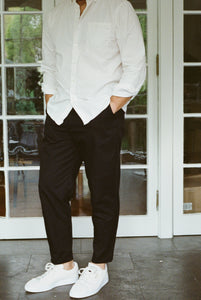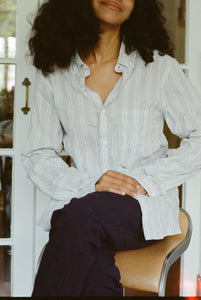
Known worldwide for innovative, Sweden-meets-Brooklyn, dishes that earned Aska two Michelin stars, Fredrik Berselius is a stoic and mild-mannered chef with a passion for pushing the limits. From foraged ingredients, picked in upstate New York, to live sea scallops, guests at Aska can expect to leave having tasted flavors they’ve never encountered before. We met Fredrik in his restaurant – mysterious and dimly lit, foraged plants placed throughout the room – to chat about his beginnings as a chef, his experience foraging ingredients, and how to make a Swedish potato pancake.
Steven Alan:
You started at some of the best restaurants that exist and now have your own, what was the impetus for you venturing out? When did you know it was time?
Fredrik: When I decided that I wanted to cook for a living, I decided that I also wanted to have my own restaurant. It became a goal early on. It had to do wanting creative freedom, to express ideas that I had – whether in food, a way of eating, or the restaurant itself.
SA: How old were you when you first started cooking?
F: I started cooking relatively late. I dabbled in my late teens, but it wasn’t until after I was twenty something when I decided to really go for it. After high school, I came to New York for the first time and spent a couple of months here just visiting and exploring. I would go and visit my sister in the UK – where she was studying hospitality and hotel management- and cook for us. That’s where I got my first introduction to the hospitality world. I think that planted a seed and I kept it in the back of my mind when I would spend time over there, helping out in the kitchen, cooking as a side job. But I initially thought that I wanted to be in design. I studied a bit of graphic design, a bit of interior design, and even engineering; wanting to potentially be an architect. But then I realized how much I loved cooking when I took a kitchen job in New York, just to pay rent.

SA: When was that?
F: In 2002. I kept asking myself if this was something that I wanted to do. And I knew that if I decided to go for it, I wanted to just put all my energy and effort into it. I knew I wanted to be in New York. I fell in love with New York as soon as I stepped foot here. But I miss parts of Sweden, growing up in Scandinavia, and I soon realized that cooking could be a way of expressing that creatively and would give me the opportunity to have a relationship with Sweden despite the distance. To cook with flavors from that region, or cook with my memories of foraging, fishing, picking berries and mushrooms. I found that, in New York, I could get the best of both worlds. It’s a big city, the greatest city on the planet, but you also have access to vast forests upstate.
SA: When you go into the forest, can you identify what’s edible and what’s not?
F: Yes. One of my biggest inspirations in life is my grandfather, who was a big nature man. I remember growing up and strolling through the woods with him. He would point out, “You can nibble on this, and you can eat that.” And that’s how it started. If you get an early introduction to wildlife, it sort of sticks with you.
SA: One of the things you’re known for is your innovation in terms of the way you prepare your food. So what drives you, and where do you look for inspiration?
F: I’m inspired by everything. I’m inspired by where we are. Nature is obviously a huge inspiration to me. I’m inspired by art and architecture, music and design...I think, to me, they all sort of correlate. I try not to look at other restaurants for inspiration, but the team and I constantly ask ourselves if what we do makes sense. Are we pushing ourselves enough? Are we trying to be creative for the sake of being creative? What’s the goal, what’s the idea behind what we’re doing here, or how we’re serving it, and can we change it, make it better? Does it taste good? Interesting isn’t good enough. What’s the connection, what happens in your head when you eat this dish? I want it to take you places.


SA: So, two Michelin stars. That’s a big deal. I’m just thinking of it as an Oscar to an Actor. Most actors would say that it’s a tremendous deal to win an award like this, and some are more like, “Well, thanks, but it’s not just about this.” But for you, was it a dream?
F: It was a dream, of course, to get the recognition. I think, again coming from Europe, it’s a very, very, very big honor. We want to always be able to cook the food that we like to cook. You can’t just cook for the Michelin stars, but if you’re cooking the way you want to cook and only have ten tables in the restaurant, it definitely helps.
SA: What are some of your favorite dishes on the Aska menu?
F: So, the menu’s rather long. We actually have two. One menu is ten courses and the other is nineteen. They were built out to be sort of a progression, it goes up and down, but somehow it all relates. I like when we can serve something that a guest hasn’t had before. There’s this lichen dish – reindeer moss – that we pick in the Catskills, which I love.

SA: Is there anything else that you want the guests to take away, having had – say - your nineteen-course meal?
F: I want them to have a delicious meal. I want them to take away both new and old flavors. I want the food to connect them back to good ingredients, high-quality ingredients. I want them to taste food as it’s supposed to taste. It could be ingredients that we handpicked ourselves or scallops that are still alive when you eat them. It’s a way to connect to what’s going on around you; it’s a way to connect to the seasons. It’s a way to connect to New York and my memories of Sweden.

Potato Pancakes
Ingredients:
2 large potatoes
3 tablespoons clarified butter
2 tablespoons lingonberries
2 tablespoons sour cream
2 tablespoons Finnish caviar
Method:
1. Peel potatoes.
2. On a box grater, grate the potatoes on a medium setting.
3. Squeeze out any excess liquid.
4. Use your hands to shape into 4 patties.
5. Heat the butter in a cast iron pan and fry the potato pancakes over a medium-low heat for about 3 minutes on each side, turning carefully and adding more butter, if needed.
6. Serve potato pancakes topped with lingonberries and sour cream or caviar and sour cream.
Learn more about Fredrik Berselius’ double Michelin-starred Aska here.
Photos by Heather Sten



